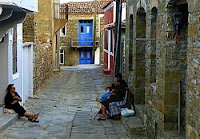Historic Cappadocia
was a large country that covered much of east-central Anatolia, with
Kayseri as its capital. In modern travel talk the name refers to a much
smaller area bounded by the towns of Aksaray, Özkonak, İncesu, Yeşilhisar, and Niğde. Its hub is a 15 by 15 km triangle formed by Nevşehir, Ürgüp and Avanos.
The land
The fantastic landscape is the product of three volcanoes – the Erciyas, Melendiz and Hasandağı – whose prehistoric eruptions covered the earth with a blanket of ash.
The top sights- the monastery valley of Göreme, the cave village of Zelve, the castle of Uçhisar, and the underground towns of Kaymaklı or Derinkuyu – are on everybody’s seelist; so they are permanently crowded with tourist.
Mercifully, plenty of other highlights
remain almost undiscovered. Many lie in a compact area that is barely a
half hour’s drive from end to end.
Hiking is a good way to begin to fall in love. Choices range from a half-hour stroll in Love Valley to a full 6-hour trek along the Ihlara Gorge (Ihlara Valley). Another way to make sure you leave your heart behind is to go hot-air ballooning.
Cappadocia is advertised as one of the world’s best terrains for that
activity, and several companies are there to let you take advantage.
when to go to cappadocia
Summer is hot and crowded, and winter
can be bleak. May and June are delighful, thogh noting, in our opinion,
beats the turing of the leaves in late Semtember and early October.
Where to stay in Cappadocia
Ürgüp, Göreme, Uçhisar and Avanos
are lively towns that offer some lovely accommodation-mostly in caves
or even inside fairy chimneys-in addition to interesting shoping and a
few decent restaurants. They are your obvious chois for headquarters,
though you may also want to spend a night or two in the quieter settting
of out-of-the-way towns like Mustafapaşa or Güzelyurt.
Checklist
Here’s a highly un-objective list of our personal favourites. You may be totally alone at several of them.
Hiking the Kızılçukur Valley to Çavuşin
Love Valley near Göreme
Church of St Theodore in Yeşilöz
The back way to İbrahimpaşa from Ortahisar.
Mustafapaşa town
Soğanlı
Erdemli Valley
Gümüşler Monasatery near Niğde
Güzelyurt and the Red Church
Ihlara Valley
Mokissos/Helvadere
Tags: Aksaray, Avanos, Cappadocia, castle of Uçhisar, central Anatolia, Church of St Theodore in Yeşilöz, east-central Anatolia, Erdemli Valley, Göreme, Gümüşler Monasatery, Güzelyurt, Helvadere, Hiking the Kızılçukur Valley to Çavuşin, Historic Cappadocia, hot air ballooning in turkey cappadocia, hot-air ballooning, Ihlara Gorge, Ihlara Gorge cappadocia, Ihlara Valley, Ihlara Valley cappadocia, İncesu, Love Valley, Love Valley cappadocia, Love Valley near Göreme, Mokissos, Mustafapaşa, Mustafapaşa town, Nevsehir, Niğde, Özkonak, Soğanlı, The back way to İbrahimpaşa from Ortahisar, the Red Church, turkey, underground town of Kaymaklı, underground towns, underground towns of Cappadocia, underground towns of Derinkuyu, underground towns of Kaymaklı, Ürgüp, ürgüp or göreme, when to go to cappadocia, when to go to cappadocia Turkey, when to go to Turkey, where to stay in cappadocia, where to stay in cappadocia urgup or goreme, where to stay in göreme, where to stay in ürgüp, where to stay in ürgüp or göreme, Yeşilhisar, Zelve






.jpg)

























